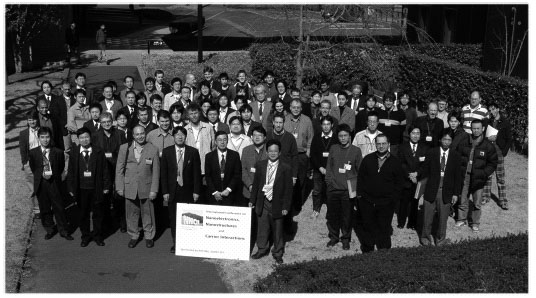The international conference on nanoelectronics, nanostructures and carrier
interactions (NNCI2007) was held from February 21 to 23, 2007, at the NTT
Atsugi R&D Center in collaboration with Solution Oriented Research for Science and
Technology (SORST) sponsored by the Japan Science and
Technology Agency (JST).
Ultra-small "nano-scale" structures and the behavior of carriers
in these structures have been the focus of a lot of attention for many
years. Recently, the field has been advanced significantly through the
introduction of additional degrees of freedom, such as electron and nuclear
spin, magnetism, and mechanical motion. In addition, novel quantum mechanical
concepts such as quantum computing and quantum cryptography are attracting
a great deal of interest. With the aim of further advancing these studies,
this conference aspired to gather leading scientists and provide forum
for discussing the most recent topics in nanoelectronics, nanostructures,
and carrier interactions. The conference was chaired by Dr. Toshimasa Fujisawa
and Dr. Hiroshi Yamaguchi of NTT Basic Research Laboratories, together
with Prof. Yoshiro Hirayama of Tohoku University.
On February 21, after the opening and welcoming remarks by Dr. Junji
Yumoto, Director of NTT Basic Research Laboratories, the technical session
was opened with the plenary talk "Architecture for a Shor Factorization
Engine Based on Semiconductor Spins" by Prof. E. Yablonovitch from
University of California, Los Angeles. There were 17 oral presentations
on coherent spin control, quantum information processing, 2-dimensional
systems, metal-insulator transition, and electron transport in quantum
dots, and 20 poster presentations. On the 22nd, the 15 oral presentations
discussed nanowires and nanotubes, novel heterostructures, spintronics,
and novel spin materials, and 20 posters were presented. On the 23rd, there
were 15 oral presentations on scanning probe spectroscopy and imaging,
electron correlation and interference, silicon nanoelectronics, and spin-related
phenomena in nanostructures. We believe that we provided a very nice opportunity
for mutual communication within and among the related research fields.
The participants were totally 145 people. All participants well enjoyed
the high-quality presentations and discussions on nanoelectronics, nanostructures,
and carrier interactions.
